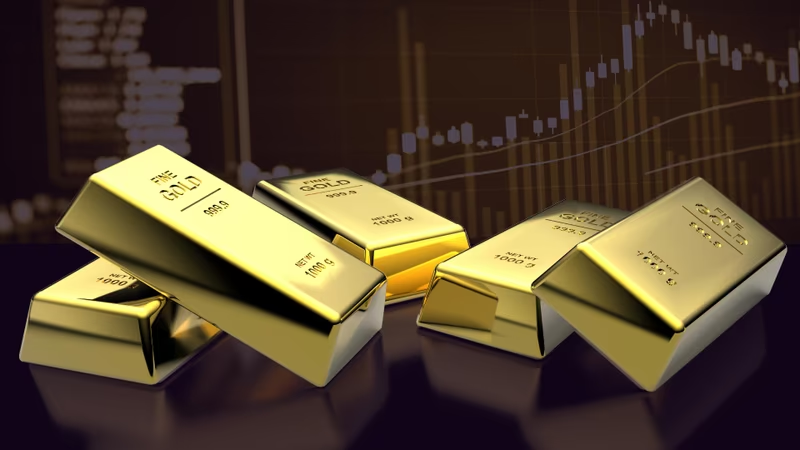What are the factors affecting gold prices? What makes gold prices go up? Continue reading to know everything about the gold rates.
Gold has been an important element in Indian culture since the beginning of time. Throughout history, it has been recognized as a significant monetary item.
We've gotten used to its particular yellow hue and its perceived value as a desirable commodity. That's why, Gold is one of the world's most well-known assets or commodities.
However, if you're considering investing in this precious metal, you should be aware that there are several factors affecting gold prices.
Before you start investing in Gold, it's important to learn what affects gold prices.
1. Demand and Supply
It is believed that gold has been mined and desired for at least 5,000 years. This precious metal is expected to stay valuable even if the price varies frequently.
What affects the price of gold the most?
It's essential to know the gold price is influenced by different factors like manufacturing costs, money supply, financial or geopolitical stability as well as jewelry and industry demand.
To put it another way, gold is a finite resource, and as global economic conditions make it more appealing, gold demand rises, causing gold prices to climb.
In the long run, however, gold's actual worth remains pretty consistent, and the price may merely represent transitory uncertainty or simple currency changes.
But what drives gold price in India?
Religious beliefs have a big role to play in gold demand and cost. Gold demand surges during auspicious festivals like Dhanteras, Diwali, Ganesh Chaturthi, and Akshaya Tritiya as well as the wedding season.
Furthermore, gold is not just used to make jewellery; it is also used to make electronic equipment.
All of these elements work together to cause demand to fluctuate depending on the season and manufacturing capacity.
2. Inflation
When inflation rises, the value of the currency decreases, making it less valuable in terms of purchasing power. Additionally, rising inflation also affects various investments.
But why is the gold price increasing with inflation?
The price of gold tends to go up when inflation is high because people buy gold as a hedge against inflation as fluctuations in the value of currency do not affect the value of gold.
Thus investing in gold can indeed diversify your investment portfolio and potentially help decrease overall risk.
3. Government Reserves
The Reserve Bank of India (RBI) is the central bank of India. The RBI holds gold reserves, and its decisions to buy or sell gold act as one of the significant factors affecting gold prices.
When the RBI buys gold, it increases the demand for gold, which drives up prices. And when the RBI sells gold, it decreases the demand for gold, which drives down prices.
4. Interest Rates
Interest rates and gold have an adverse connection. The current gold prices are a reliable indicator of the country's interest-rate trends.
When the rate of interest rises, clients are more likely to sell gold in order to acquire a monetary value, increasing the supply of gold and lowering its price.
What is the reason for gold going up? When interest rates are low, people have more cash on hand which could lead to increased demand for gold, resulting in a price hike.
5. Jewellery Market
In India, gold jewelry is integral to most religious festivals and weddings making the jewellery market a major driver of gold demand in India.
When the jewellery market is doing well, it increases the demand for gold, which drives up prices making it one of the most crucial factors affecting gold prices.
A report by the World Gold Council (WGC) in 2019 estimated that around 25,000 tonnes of gold have been accumulated by Indian households, making India the world’s largest holder of gold.
6. Monsoons
Demand for gold is influenced by rural demand, with rural markets accounting for the majority of gold purchases in India.
Rural India’s annual Gold consumption is estimated to be 800-850 tons.
Good monsoons contribute as one of the major factors affecting gold prices. As good monsoons also result in good harvests, the money generated from it is invested in gold in rural regions as it holds immense value.
7. Geopolitical Factors
Geopolitical factors can also affect gold prices. When there is political uncertainty or instability, investors often turn to gold as a safe-haven asset.
This can drive up gold prices. Conversely, when there is political stability, investors may be less likely to buy gold, which can drive down the prices.
Globally, any movement in the price of gold affects its price in India, considering India is one of the largest consumers of gold.
8. Import Duty
As Gold is not produced in India, it must be imported, therefore import duty has a significant effect on price changes. Import tariffs have a substantial impact on price fluctuations.
Import duty is imposed on the value of the gold when it enters the country.
The higher the import duty, the more expensive it is to import gold, which will in turn push up the price of gold in the domestic market.
India has less than one percent contribution to global gold production. However, India is the second-largest consumer of this precious metal.
9. Currency Fluctuations
The value of exchange rates, or the price of one currency in terms of another, can fluctuate over time and be rather volatile at times.
The price of Gold tends to fall in US dollar terms as the dollar's value rises in relation to other currencies throughout the world.
This is the case because Gold is more expensive in other currencies. Gold, on the other hand, tends to climb as the US dollar's value declines and it becomes cheaper in other currencies.
This is why many Gold investors pay close attention to the US dollar and currency exchange rates.
10. Protection from volatility or uncertainty
Gold is often seen as a safe haven asset, meaning that it is seen as a way to protect wealth during times of volatility or uncertainty.
Also, gold is not closely related to other asset classes, such as stocks or bonds.
This means that when the prices of stocks or bonds go down, the price of gold may not go down as much or may even go up.
This makes gold a good investment to protect against losses in other markets.
When investors are worried about the future, they may buy gold as a way to safeguard their assets. This can drive up gold prices.
In 2020, gold prices also rose as investors became more concerned about the economic impact of the COVID-19 pandemic.
11. Correlation With Other Assets
There is an inverse relationship between the Sensex and Gold prices.
When investors detect a bullish trend in the stock market, they want to increase their stock investments in order to benefit from rising stock prices in the future.
With this shift in desire, Gold demand falls, decreasing Gold prices.
When the stock market falls and investors believe the bearish trend will continue for some time, they choose to put their extra funds in safe-haven assets like Gold, which causes Gold demand and prices to climb.
12. Crude Oil Prices
Crude oil is a very volatile commodity in international markets. But what is the reason for gold going up?
Crude oil is a major input in many industries, and its price fluctuations can have a ripple throughout the economy.
Crude oil prices and gold prices are often linked.
When crude oil prices go up, it can lead to higher inflation, which can prompt investors to seek gold as a hedge against inflation. This can increase the demand for gold and drive up its price.
However, the relationship between crude oil prices and gold prices is not always straightforward.
There are other factors that can also affect gold prices, such as interest rates and economic conditions.
Also, Gold and crude oil are both affected by a fluctuating US dollar. A weak dollar could lead to a dramatic rise in crude oil and Gold prices.
Think about the factors affecting gold prices and make sure your assets are in line with your risk tolerance and investing strategy.
Have a comprehensive understanding of the gold situation before you invest.
If you want to start small, go with Digital Gold.
Over the last few years, customers have been progressively going for Digital Gold due to the convenience of access, cost, and security, which is underlined by the growing trust in digital payment platforms.
You can easily buy 24K Gold with a single click.
You even have the option to automate your investment on the Jar app, if you don't want to go through the hassle of opening the apps and investing money every time.
Jar app automatically invests your saved change from online transactions into Digital Gold, helping you accumulate Digital Gold for a secure future.
You can set an amount to be deducted from your account and invest every day.
Add Digital Gold to your investment portfolio to give it stability among the other high-risk instruments. Download the Jar app.










